Developing Teaching, Learning, and Assessment in Education Report
VerifiedAdded on 2023/06/18
|7
|1903
|281
Report
AI Summary
This report provides an analysis of pedagogical principles, theories of behavior management, and creative approaches to managing the learning environment within the context of education and training. Task A explores the application of pedagogical principles like specialist knowledge, kinaesthetic learning, scaffolded learning, and active engagement, evaluating their strengths and weaknesses. It also examines the effectiveness of creative and innovative approaches such as flexible online learning and collaborative work. Furthermore, it explains the application of behaviorism, cognitivism, and constructivism theories in planning inclusive teaching. Task B discusses Herzberg’s Motivational Theory and Maslow’s Hierarchy of Needs, explaining how these theories inform the creation and maintenance of a safe and inclusive teaching and learning environment. The report emphasizes the importance of motivational strategies and addressing basic needs to improve student performance and create a positive learning climate.
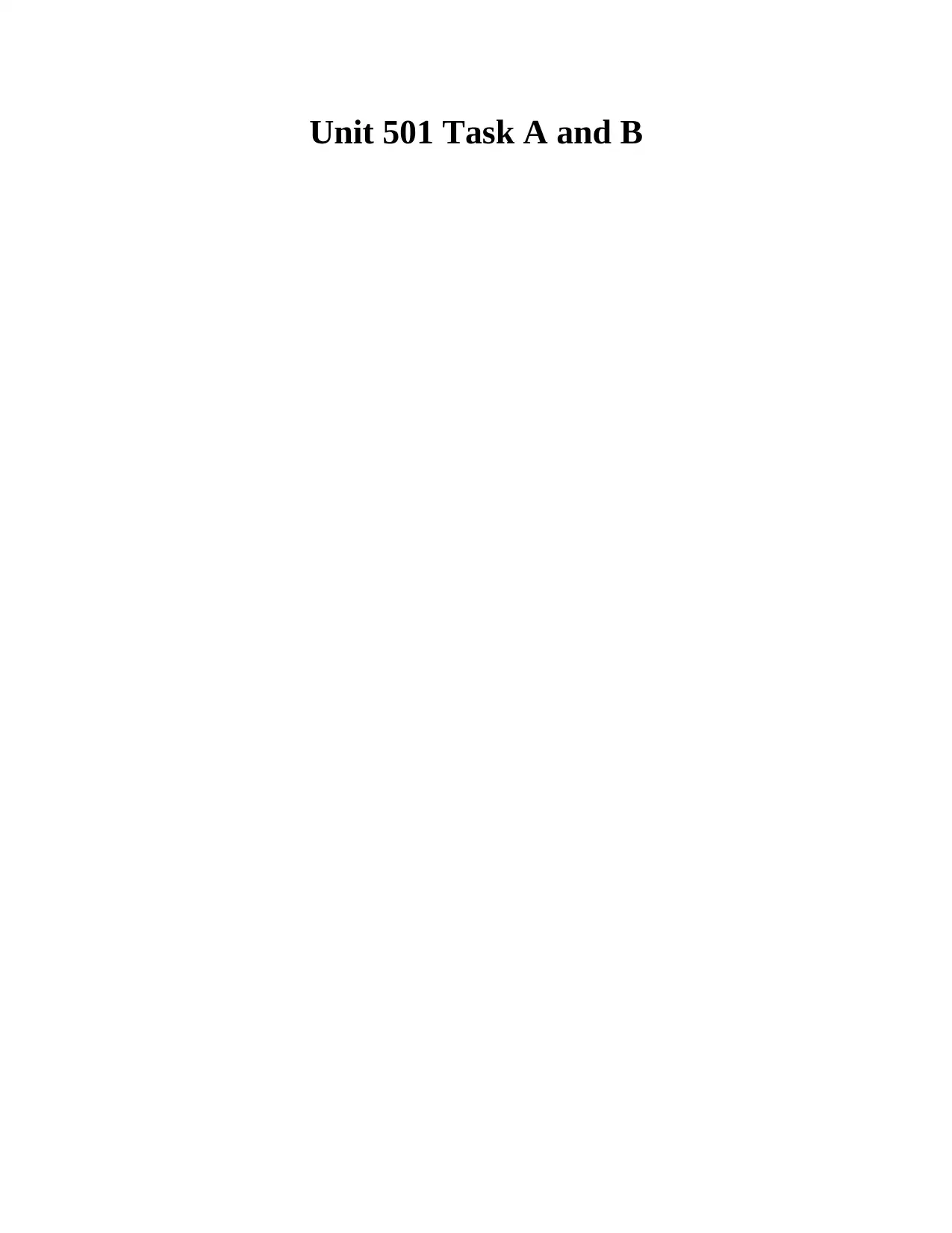
Unit 501 Task A and B
Paraphrase This Document
Need a fresh take? Get an instant paraphrase of this document with our AI Paraphraser
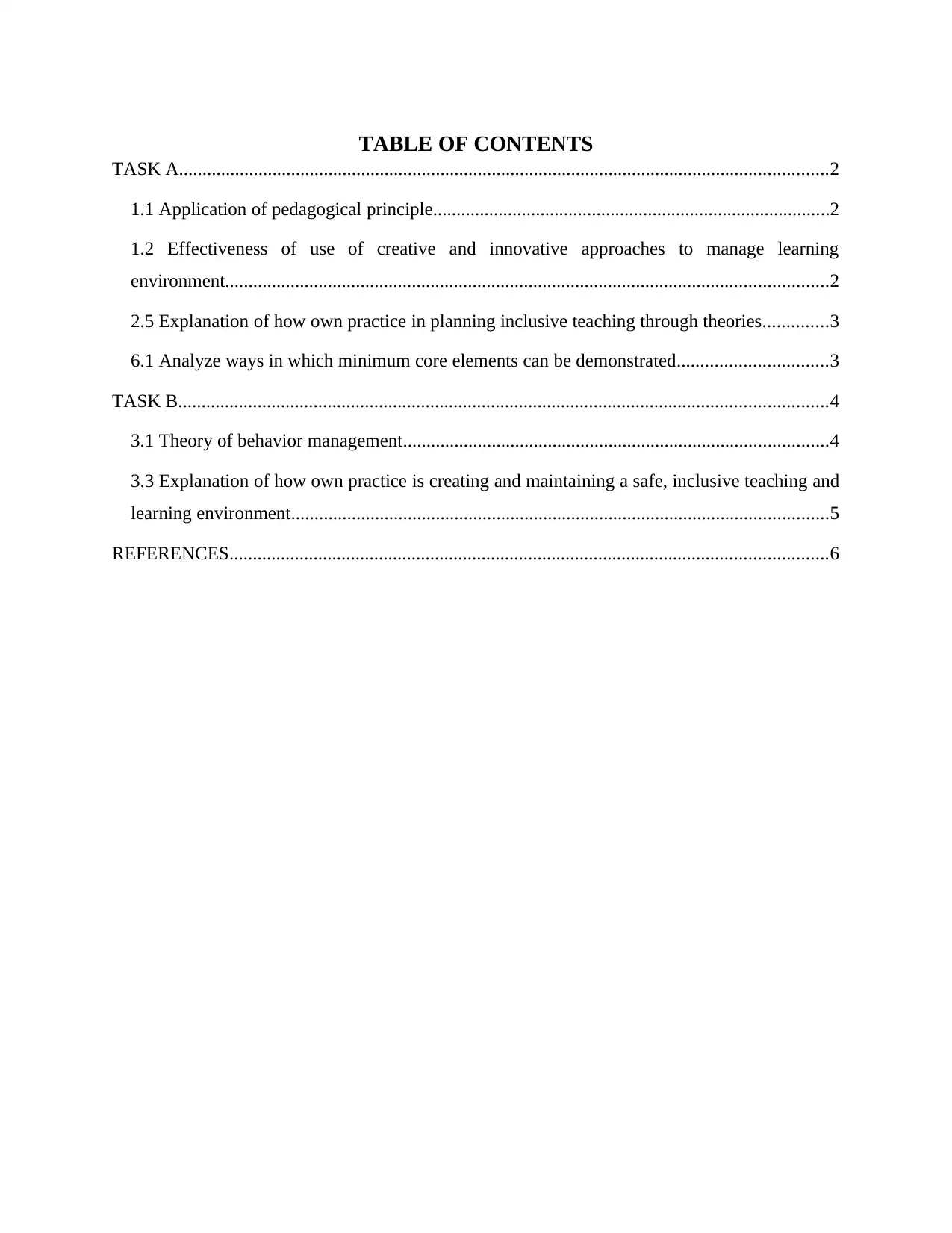
TABLE OF CONTENTS
TASK A...........................................................................................................................................2
1.1 Application of pedagogical principle.....................................................................................2
1.2 Effectiveness of use of creative and innovative approaches to manage learning
environment.................................................................................................................................2
2.5 Explanation of how own practice in planning inclusive teaching through theories..............3
6.1 Analyze ways in which minimum core elements can be demonstrated................................3
TASK B...........................................................................................................................................4
3.1 Theory of behavior management...........................................................................................4
3.3 Explanation of how own practice is creating and maintaining a safe, inclusive teaching and
learning environment...................................................................................................................5
REFERENCES................................................................................................................................6
TASK A...........................................................................................................................................2
1.1 Application of pedagogical principle.....................................................................................2
1.2 Effectiveness of use of creative and innovative approaches to manage learning
environment.................................................................................................................................2
2.5 Explanation of how own practice in planning inclusive teaching through theories..............3
6.1 Analyze ways in which minimum core elements can be demonstrated................................3
TASK B...........................................................................................................................................4
3.1 Theory of behavior management...........................................................................................4
3.3 Explanation of how own practice is creating and maintaining a safe, inclusive teaching and
learning environment...................................................................................................................5
REFERENCES................................................................................................................................6
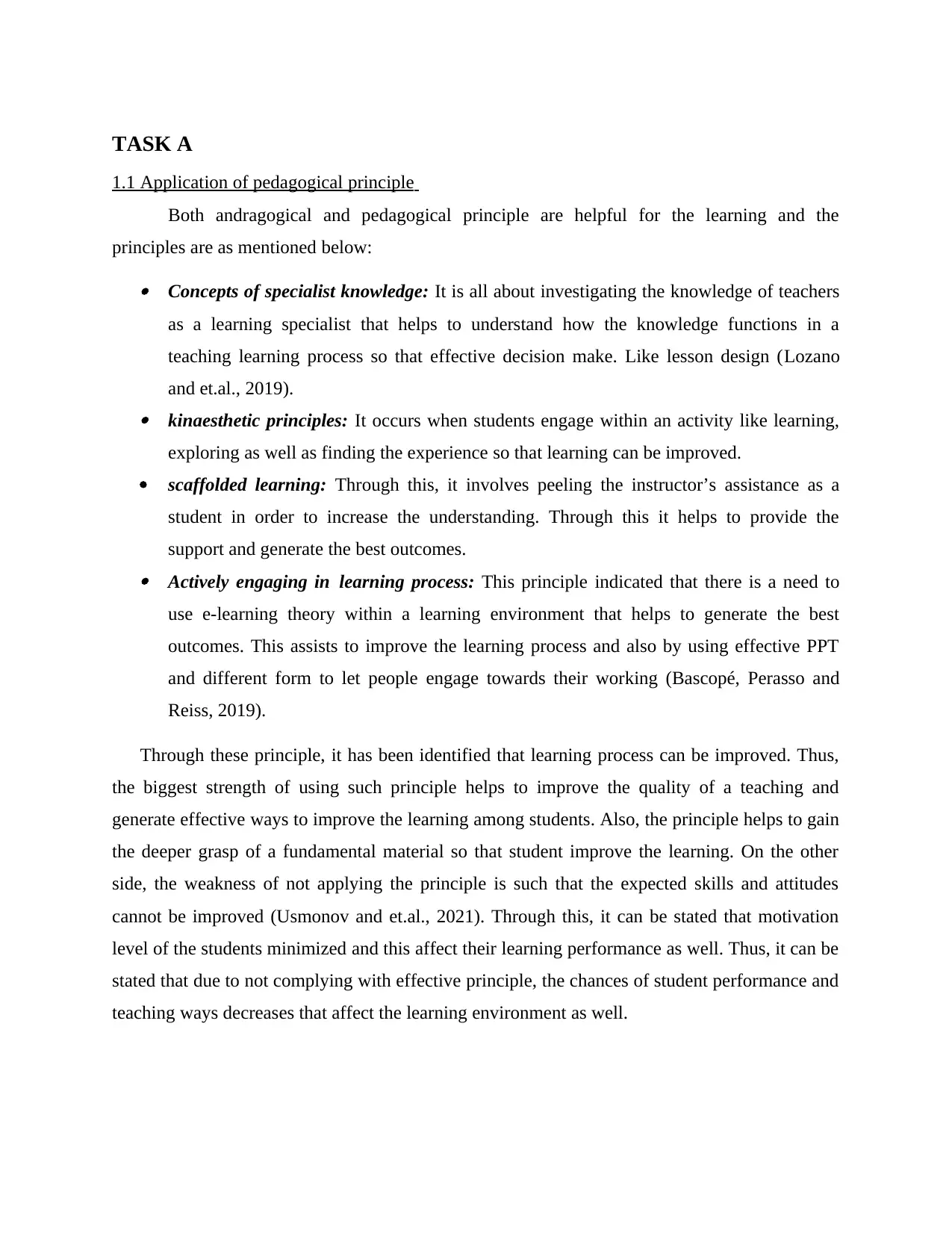
TASK A
1.1 Application of pedagogical principle
Both andragogical and pedagogical principle are helpful for the learning and the
principles are as mentioned below: Concepts of specialist knowledge: It is all about investigating the knowledge of teachers
as a learning specialist that helps to understand how the knowledge functions in a
teaching learning process so that effective decision make. Like lesson design (Lozano
and et.al., 2019). kinaesthetic principles: It occurs when students engage within an activity like learning,
exploring as well as finding the experience so that learning can be improved.
scaffolded learning: Through this, it involves peeling the instructor’s assistance as a
student in order to increase the understanding. Through this it helps to provide the
support and generate the best outcomes. Actively engaging in learning process: This principle indicated that there is a need to
use e-learning theory within a learning environment that helps to generate the best
outcomes. This assists to improve the learning process and also by using effective PPT
and different form to let people engage towards their working (Bascopé, Perasso and
Reiss, 2019).
Through these principle, it has been identified that learning process can be improved. Thus,
the biggest strength of using such principle helps to improve the quality of a teaching and
generate effective ways to improve the learning among students. Also, the principle helps to gain
the deeper grasp of a fundamental material so that student improve the learning. On the other
side, the weakness of not applying the principle is such that the expected skills and attitudes
cannot be improved (Usmonov and et.al., 2021). Through this, it can be stated that motivation
level of the students minimized and this affect their learning performance as well. Thus, it can be
stated that due to not complying with effective principle, the chances of student performance and
teaching ways decreases that affect the learning environment as well.
1.1 Application of pedagogical principle
Both andragogical and pedagogical principle are helpful for the learning and the
principles are as mentioned below: Concepts of specialist knowledge: It is all about investigating the knowledge of teachers
as a learning specialist that helps to understand how the knowledge functions in a
teaching learning process so that effective decision make. Like lesson design (Lozano
and et.al., 2019). kinaesthetic principles: It occurs when students engage within an activity like learning,
exploring as well as finding the experience so that learning can be improved.
scaffolded learning: Through this, it involves peeling the instructor’s assistance as a
student in order to increase the understanding. Through this it helps to provide the
support and generate the best outcomes. Actively engaging in learning process: This principle indicated that there is a need to
use e-learning theory within a learning environment that helps to generate the best
outcomes. This assists to improve the learning process and also by using effective PPT
and different form to let people engage towards their working (Bascopé, Perasso and
Reiss, 2019).
Through these principle, it has been identified that learning process can be improved. Thus,
the biggest strength of using such principle helps to improve the quality of a teaching and
generate effective ways to improve the learning among students. Also, the principle helps to gain
the deeper grasp of a fundamental material so that student improve the learning. On the other
side, the weakness of not applying the principle is such that the expected skills and attitudes
cannot be improved (Usmonov and et.al., 2021). Through this, it can be stated that motivation
level of the students minimized and this affect their learning performance as well. Thus, it can be
stated that due to not complying with effective principle, the chances of student performance and
teaching ways decreases that affect the learning environment as well.
⊘ This is a preview!⊘
Do you want full access?
Subscribe today to unlock all pages.

Trusted by 1+ million students worldwide
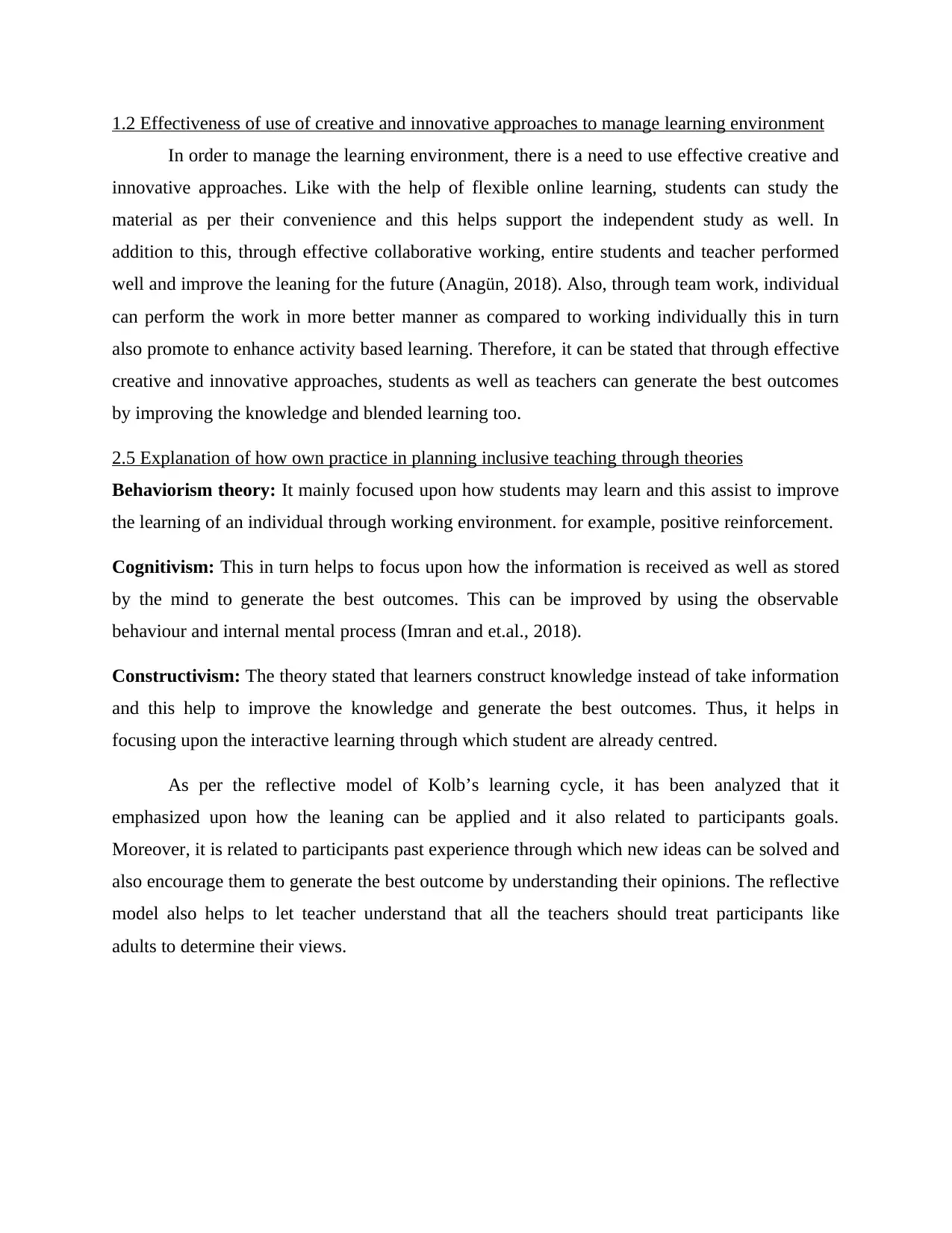
1.2 Effectiveness of use of creative and innovative approaches to manage learning environment
In order to manage the learning environment, there is a need to use effective creative and
innovative approaches. Like with the help of flexible online learning, students can study the
material as per their convenience and this helps support the independent study as well. In
addition to this, through effective collaborative working, entire students and teacher performed
well and improve the leaning for the future (Anagün, 2018). Also, through team work, individual
can perform the work in more better manner as compared to working individually this in turn
also promote to enhance activity based learning. Therefore, it can be stated that through effective
creative and innovative approaches, students as well as teachers can generate the best outcomes
by improving the knowledge and blended learning too.
2.5 Explanation of how own practice in planning inclusive teaching through theories
Behaviorism theory: It mainly focused upon how students may learn and this assist to improve
the learning of an individual through working environment. for example, positive reinforcement.
Cognitivism: This in turn helps to focus upon how the information is received as well as stored
by the mind to generate the best outcomes. This can be improved by using the observable
behaviour and internal mental process (Imran and et.al., 2018).
Constructivism: The theory stated that learners construct knowledge instead of take information
and this help to improve the knowledge and generate the best outcomes. Thus, it helps in
focusing upon the interactive learning through which student are already centred.
As per the reflective model of Kolb’s learning cycle, it has been analyzed that it
emphasized upon how the leaning can be applied and it also related to participants goals.
Moreover, it is related to participants past experience through which new ideas can be solved and
also encourage them to generate the best outcome by understanding their opinions. The reflective
model also helps to let teacher understand that all the teachers should treat participants like
adults to determine their views.
In order to manage the learning environment, there is a need to use effective creative and
innovative approaches. Like with the help of flexible online learning, students can study the
material as per their convenience and this helps support the independent study as well. In
addition to this, through effective collaborative working, entire students and teacher performed
well and improve the leaning for the future (Anagün, 2018). Also, through team work, individual
can perform the work in more better manner as compared to working individually this in turn
also promote to enhance activity based learning. Therefore, it can be stated that through effective
creative and innovative approaches, students as well as teachers can generate the best outcomes
by improving the knowledge and blended learning too.
2.5 Explanation of how own practice in planning inclusive teaching through theories
Behaviorism theory: It mainly focused upon how students may learn and this assist to improve
the learning of an individual through working environment. for example, positive reinforcement.
Cognitivism: This in turn helps to focus upon how the information is received as well as stored
by the mind to generate the best outcomes. This can be improved by using the observable
behaviour and internal mental process (Imran and et.al., 2018).
Constructivism: The theory stated that learners construct knowledge instead of take information
and this help to improve the knowledge and generate the best outcomes. Thus, it helps in
focusing upon the interactive learning through which student are already centred.
As per the reflective model of Kolb’s learning cycle, it has been analyzed that it
emphasized upon how the leaning can be applied and it also related to participants goals.
Moreover, it is related to participants past experience through which new ideas can be solved and
also encourage them to generate the best outcome by understanding their opinions. The reflective
model also helps to let teacher understand that all the teachers should treat participants like
adults to determine their views.
Paraphrase This Document
Need a fresh take? Get an instant paraphrase of this document with our AI Paraphraser
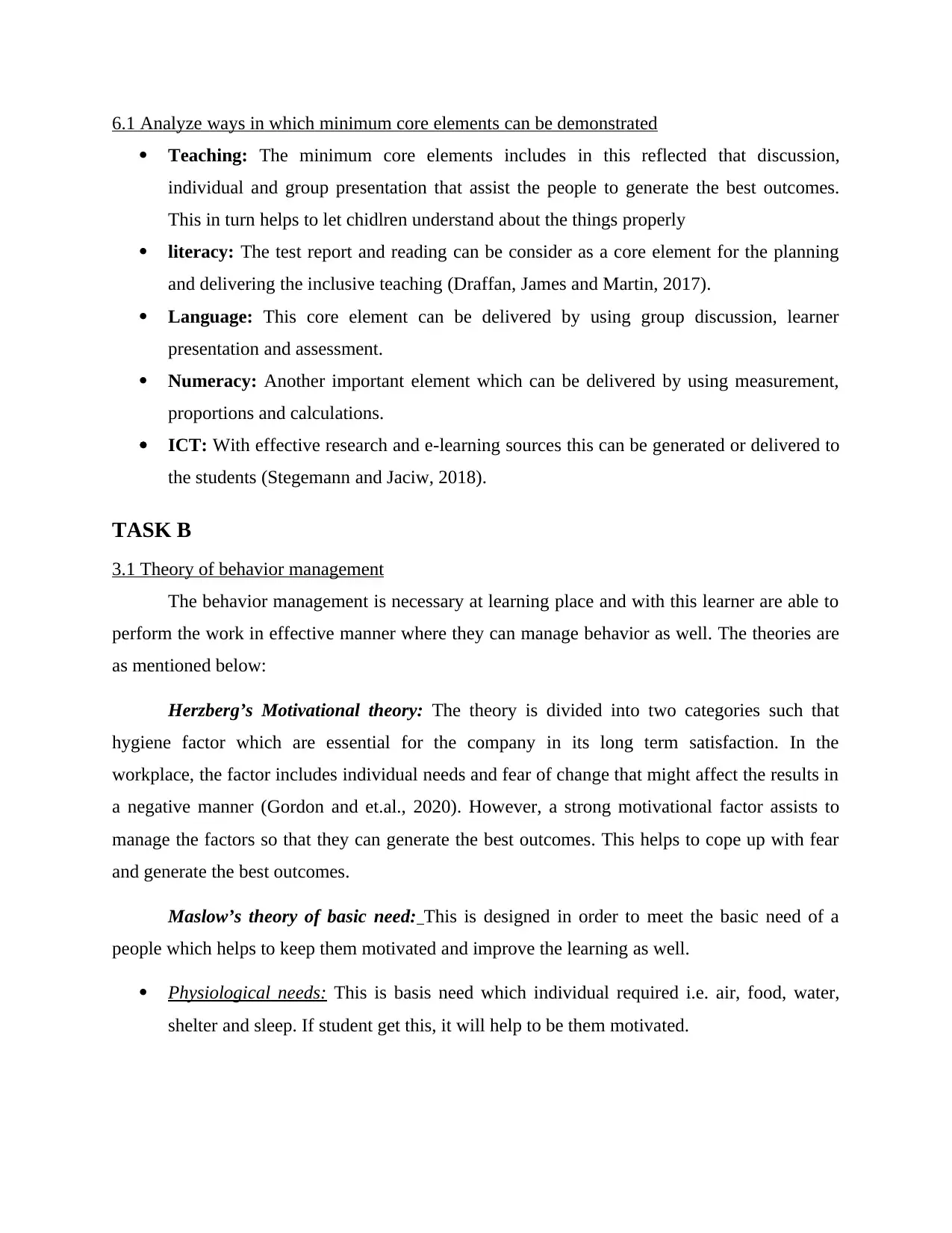
6.1 Analyze ways in which minimum core elements can be demonstrated
Teaching: The minimum core elements includes in this reflected that discussion,
individual and group presentation that assist the people to generate the best outcomes.
This in turn helps to let chidlren understand about the things properly
literacy: The test report and reading can be consider as a core element for the planning
and delivering the inclusive teaching (Draffan, James and Martin, 2017).
Language: This core element can be delivered by using group discussion, learner
presentation and assessment.
Numeracy: Another important element which can be delivered by using measurement,
proportions and calculations.
ICT: With effective research and e-learning sources this can be generated or delivered to
the students (Stegemann and Jaciw, 2018).
TASK B
3.1 Theory of behavior management
The behavior management is necessary at learning place and with this learner are able to
perform the work in effective manner where they can manage behavior as well. The theories are
as mentioned below:
Herzberg’s Motivational theory: The theory is divided into two categories such that
hygiene factor which are essential for the company in its long term satisfaction. In the
workplace, the factor includes individual needs and fear of change that might affect the results in
a negative manner (Gordon and et.al., 2020). However, a strong motivational factor assists to
manage the factors so that they can generate the best outcomes. This helps to cope up with fear
and generate the best outcomes.
Maslow’s theory of basic need: This is designed in order to meet the basic need of a
people which helps to keep them motivated and improve the learning as well.
Physiological needs: This is basis need which individual required i.e. air, food, water,
shelter and sleep. If student get this, it will help to be them motivated.
Teaching: The minimum core elements includes in this reflected that discussion,
individual and group presentation that assist the people to generate the best outcomes.
This in turn helps to let chidlren understand about the things properly
literacy: The test report and reading can be consider as a core element for the planning
and delivering the inclusive teaching (Draffan, James and Martin, 2017).
Language: This core element can be delivered by using group discussion, learner
presentation and assessment.
Numeracy: Another important element which can be delivered by using measurement,
proportions and calculations.
ICT: With effective research and e-learning sources this can be generated or delivered to
the students (Stegemann and Jaciw, 2018).
TASK B
3.1 Theory of behavior management
The behavior management is necessary at learning place and with this learner are able to
perform the work in effective manner where they can manage behavior as well. The theories are
as mentioned below:
Herzberg’s Motivational theory: The theory is divided into two categories such that
hygiene factor which are essential for the company in its long term satisfaction. In the
workplace, the factor includes individual needs and fear of change that might affect the results in
a negative manner (Gordon and et.al., 2020). However, a strong motivational factor assists to
manage the factors so that they can generate the best outcomes. This helps to cope up with fear
and generate the best outcomes.
Maslow’s theory of basic need: This is designed in order to meet the basic need of a
people which helps to keep them motivated and improve the learning as well.
Physiological needs: This is basis need which individual required i.e. air, food, water,
shelter and sleep. If student get this, it will help to be them motivated.
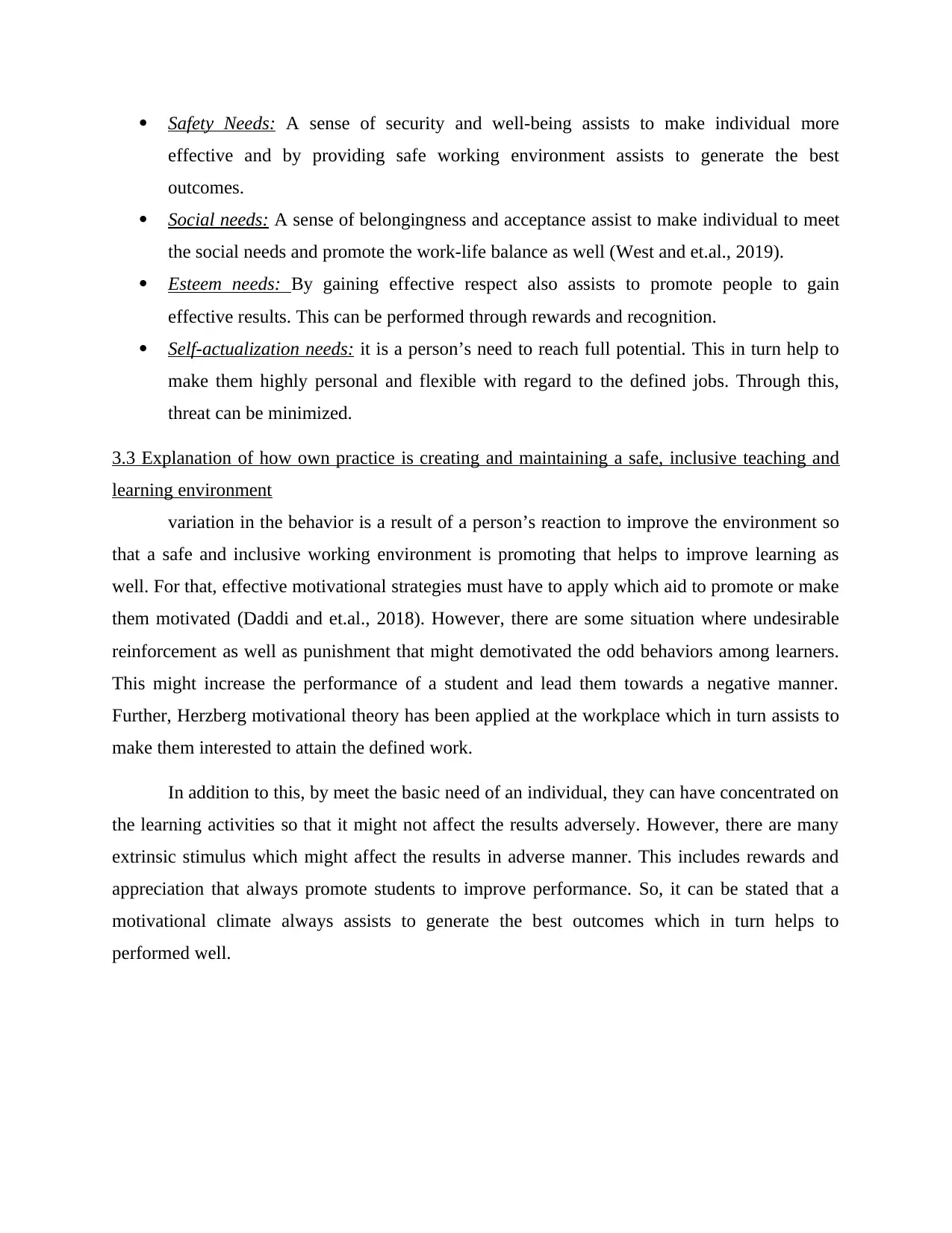
Safety Needs: A sense of security and well-being assists to make individual more
effective and by providing safe working environment assists to generate the best
outcomes.
Social needs: A sense of belongingness and acceptance assist to make individual to meet
the social needs and promote the work-life balance as well (West and et.al., 2019).
Esteem needs: By gaining effective respect also assists to promote people to gain
effective results. This can be performed through rewards and recognition.
Self-actualization needs: it is a person’s need to reach full potential. This in turn help to
make them highly personal and flexible with regard to the defined jobs. Through this,
threat can be minimized.
3.3 Explanation of how own practice is creating and maintaining a safe, inclusive teaching and
learning environment
variation in the behavior is a result of a person’s reaction to improve the environment so
that a safe and inclusive working environment is promoting that helps to improve learning as
well. For that, effective motivational strategies must have to apply which aid to promote or make
them motivated (Daddi and et.al., 2018). However, there are some situation where undesirable
reinforcement as well as punishment that might demotivated the odd behaviors among learners.
This might increase the performance of a student and lead them towards a negative manner.
Further, Herzberg motivational theory has been applied at the workplace which in turn assists to
make them interested to attain the defined work.
In addition to this, by meet the basic need of an individual, they can have concentrated on
the learning activities so that it might not affect the results adversely. However, there are many
extrinsic stimulus which might affect the results in adverse manner. This includes rewards and
appreciation that always promote students to improve performance. So, it can be stated that a
motivational climate always assists to generate the best outcomes which in turn helps to
performed well.
effective and by providing safe working environment assists to generate the best
outcomes.
Social needs: A sense of belongingness and acceptance assist to make individual to meet
the social needs and promote the work-life balance as well (West and et.al., 2019).
Esteem needs: By gaining effective respect also assists to promote people to gain
effective results. This can be performed through rewards and recognition.
Self-actualization needs: it is a person’s need to reach full potential. This in turn help to
make them highly personal and flexible with regard to the defined jobs. Through this,
threat can be minimized.
3.3 Explanation of how own practice is creating and maintaining a safe, inclusive teaching and
learning environment
variation in the behavior is a result of a person’s reaction to improve the environment so
that a safe and inclusive working environment is promoting that helps to improve learning as
well. For that, effective motivational strategies must have to apply which aid to promote or make
them motivated (Daddi and et.al., 2018). However, there are some situation where undesirable
reinforcement as well as punishment that might demotivated the odd behaviors among learners.
This might increase the performance of a student and lead them towards a negative manner.
Further, Herzberg motivational theory has been applied at the workplace which in turn assists to
make them interested to attain the defined work.
In addition to this, by meet the basic need of an individual, they can have concentrated on
the learning activities so that it might not affect the results adversely. However, there are many
extrinsic stimulus which might affect the results in adverse manner. This includes rewards and
appreciation that always promote students to improve performance. So, it can be stated that a
motivational climate always assists to generate the best outcomes which in turn helps to
performed well.
⊘ This is a preview!⊘
Do you want full access?
Subscribe today to unlock all pages.

Trusted by 1+ million students worldwide
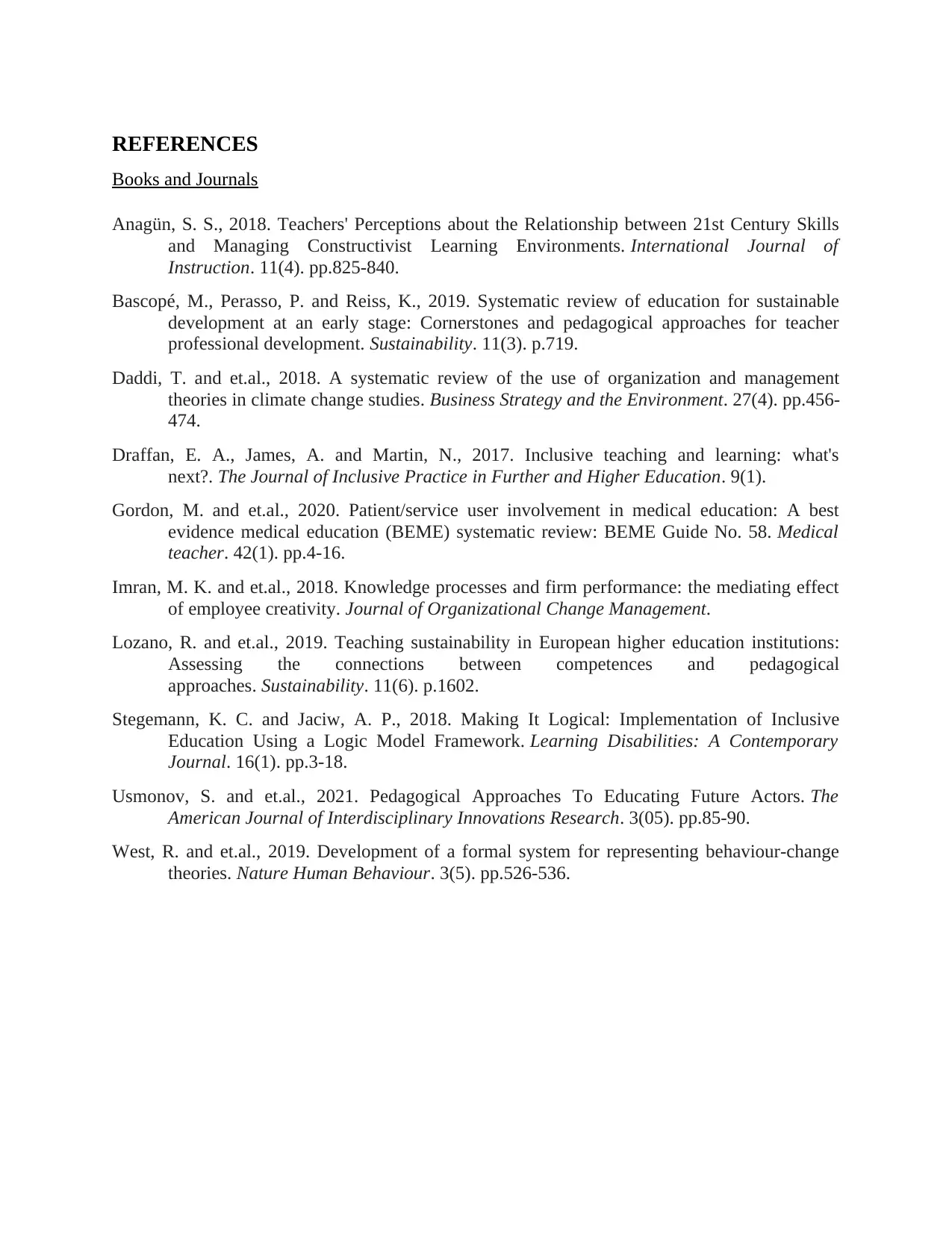
REFERENCES
Books and Journals
Anagün, S. S., 2018. Teachers' Perceptions about the Relationship between 21st Century Skills
and Managing Constructivist Learning Environments. International Journal of
Instruction. 11(4). pp.825-840.
Bascopé, M., Perasso, P. and Reiss, K., 2019. Systematic review of education for sustainable
development at an early stage: Cornerstones and pedagogical approaches for teacher
professional development. Sustainability. 11(3). p.719.
Daddi, T. and et.al., 2018. A systematic review of the use of organization and management
theories in climate change studies. Business Strategy and the Environment. 27(4). pp.456-
474.
Draffan, E. A., James, A. and Martin, N., 2017. Inclusive teaching and learning: what's
next?. The Journal of Inclusive Practice in Further and Higher Education. 9(1).
Gordon, M. and et.al., 2020. Patient/service user involvement in medical education: A best
evidence medical education (BEME) systematic review: BEME Guide No. 58. Medical
teacher. 42(1). pp.4-16.
Imran, M. K. and et.al., 2018. Knowledge processes and firm performance: the mediating effect
of employee creativity. Journal of Organizational Change Management.
Lozano, R. and et.al., 2019. Teaching sustainability in European higher education institutions:
Assessing the connections between competences and pedagogical
approaches. Sustainability. 11(6). p.1602.
Stegemann, K. C. and Jaciw, A. P., 2018. Making It Logical: Implementation of Inclusive
Education Using a Logic Model Framework. Learning Disabilities: A Contemporary
Journal. 16(1). pp.3-18.
Usmonov, S. and et.al., 2021. Pedagogical Approaches To Educating Future Actors. The
American Journal of Interdisciplinary Innovations Research. 3(05). pp.85-90.
West, R. and et.al., 2019. Development of a formal system for representing behaviour-change
theories. Nature Human Behaviour. 3(5). pp.526-536.
Books and Journals
Anagün, S. S., 2018. Teachers' Perceptions about the Relationship between 21st Century Skills
and Managing Constructivist Learning Environments. International Journal of
Instruction. 11(4). pp.825-840.
Bascopé, M., Perasso, P. and Reiss, K., 2019. Systematic review of education for sustainable
development at an early stage: Cornerstones and pedagogical approaches for teacher
professional development. Sustainability. 11(3). p.719.
Daddi, T. and et.al., 2018. A systematic review of the use of organization and management
theories in climate change studies. Business Strategy and the Environment. 27(4). pp.456-
474.
Draffan, E. A., James, A. and Martin, N., 2017. Inclusive teaching and learning: what's
next?. The Journal of Inclusive Practice in Further and Higher Education. 9(1).
Gordon, M. and et.al., 2020. Patient/service user involvement in medical education: A best
evidence medical education (BEME) systematic review: BEME Guide No. 58. Medical
teacher. 42(1). pp.4-16.
Imran, M. K. and et.al., 2018. Knowledge processes and firm performance: the mediating effect
of employee creativity. Journal of Organizational Change Management.
Lozano, R. and et.al., 2019. Teaching sustainability in European higher education institutions:
Assessing the connections between competences and pedagogical
approaches. Sustainability. 11(6). p.1602.
Stegemann, K. C. and Jaciw, A. P., 2018. Making It Logical: Implementation of Inclusive
Education Using a Logic Model Framework. Learning Disabilities: A Contemporary
Journal. 16(1). pp.3-18.
Usmonov, S. and et.al., 2021. Pedagogical Approaches To Educating Future Actors. The
American Journal of Interdisciplinary Innovations Research. 3(05). pp.85-90.
West, R. and et.al., 2019. Development of a formal system for representing behaviour-change
theories. Nature Human Behaviour. 3(5). pp.526-536.
1 out of 7
Related Documents
Your All-in-One AI-Powered Toolkit for Academic Success.
+13062052269
info@desklib.com
Available 24*7 on WhatsApp / Email
![[object Object]](/_next/static/media/star-bottom.7253800d.svg)
Unlock your academic potential
Copyright © 2020–2025 A2Z Services. All Rights Reserved. Developed and managed by ZUCOL.


